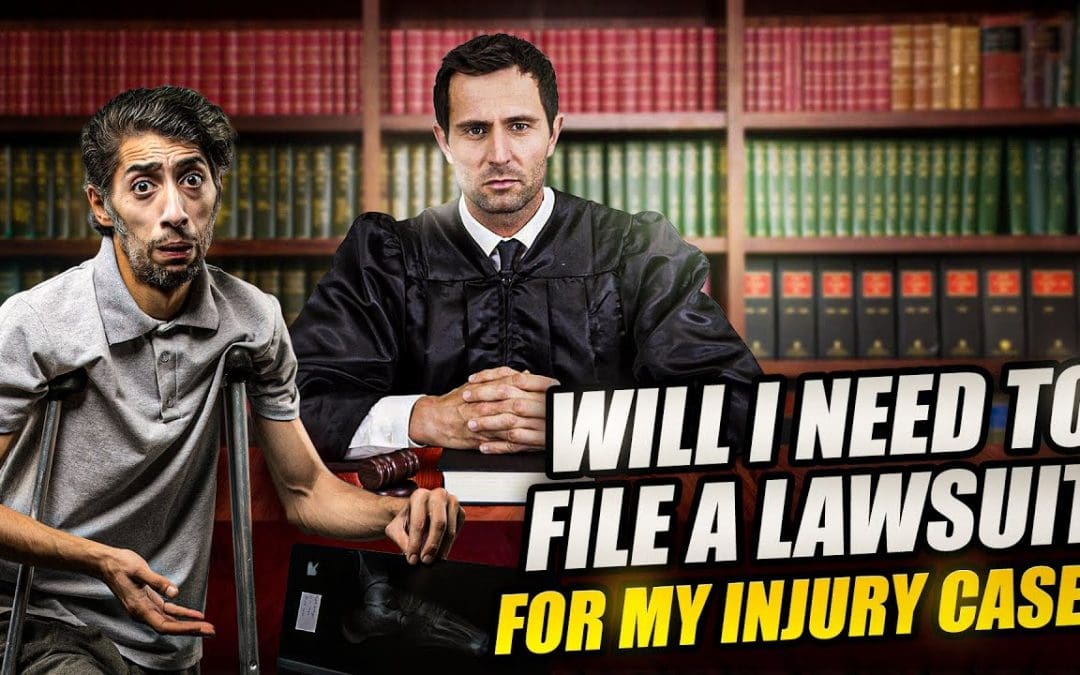Many injury cases are settled without the need to file a lawsuit or ever go to court. But many times, the insurance companies and corporate defendants of the world fail to make a fair and reasonable offer before an injury victim files a lawsuit. In this video, I’ll discuss when it makes sense to file a lawsuit in your injury case.
The Story of Sandy
To start things off, let me tell you the story of Sandy. A short time ago, Sandy contacted me and asked me to represent her for her car accident injury claim. Liability in Sandy’s case was not at issue, as the driver who caused the accident was clearly at fault and the at-fault driver’s insurance company never disputed liability.
However, Sandy had a history of issues with her neck and back prior to her motor vehicle accident. She told me her car accident worsened her condition, causing significant aggravation to her neck and lower back. Sandy did not seek immediate medical attention after her car accident. A couple of days after her accident, she called her previous doctor’s office, where she had been treated, to report that she had been in an accident and to schedule an appointment.
Initial Challenges and Insurance Company Response
Sandy was not seen by any medical provider until two months after her accident. At that time, her medical records reflected that she complained of pain that was worsening. She was next seen almost five months after her accident, at which time she again complained that her pain was worsening. During this time, Sandy had been handling her injury claim on her own and had gotten nowhere by the time she called me. The insurance company had not offered her a penny and was being difficult with her.
Taking Over the Case
When Sandy called me, she was lost as to what to do next. She was in bad shape and needed surgery on her neck. She had her first surgery on her neck eight months following her accident and needed a second surgery just a few days later. After I obtained her medical records from her surgeries, I sent a written demand to the at-fault driver’s insurance company, demanding that they pay out their insured driver’s insurance policy limits.
In response to my written demand, the insurance company only offered to settle the case for $5,000, arguing that the first time Sandy had reported cervical pain after the accident was at her doctor’s visit five months after the accident, and that in those records, it notes that her pain began four to five years ago and was worsening, but did not mention the motor vehicle accident.
Important Lesson
Side note, this is an important lesson: insurance companies heavily rely on medical records when adjusting injury claims. It’s a good idea to remind your medical providers every time you visit after a car accident that you had been in a car accident which caused your pain, and hope that the medical provider puts it in their medical records. If it winds up in your medical records that you’ve been involved in an accident, it will make it easier sailing with the insurance company.
Independent Medical Exam and Filing a Lawsuit
Sandy and I were not happy with the $5,000 offer. I recommended she see an independent doctor for an independent medical exam. She did, and the doctor linked the need for her surgeries to her auto accident. I sent this doctor’s report to the insurance company and again demanded that the insurance company for the at-fault driver pay out the policy limits. The insurance company again argued that Sandy’s medical condition was pre-existing and that her medical treatment, including her surgeries, was not related to the automobile accident. They then only offered $7,500 in the spirit of coming to a compromise in settling her case, according to the insurance adjuster.
In response, I immediately filed a lawsuit. After litigating the case for a short period, I was finally able to get the insurance company to come to its senses. They finally offered their six-figure policy limits, and the case was settled.
The Lesson
So what’s the lesson here? Clearly, in Sandy’s case, it was worth filing a lawsuit. Her damages were significant as she had two surgeries, and the insurance company had only offered us $7,500 to settle her case prior to us filing the lawsuit. By filing a lawsuit, an insurance company or corporate defendant knows that they will not only have to pay a defense attorney by the hour to defend the lawsuit, but they will also rack up case expenses to defend the lawsuit. Their defense attorney will need to take depositions, and they may even eventually have to hire an expert. After a lawsuit is filed, it can get costly for the insurance company; it’s something the insurance company will consider when evaluating your claim.
Filing a Lawsuit
Filing a lawsuit also puts pressure on the insurance company to make you a fair and reasonable offer in your case. If you end up getting a verdict in excess of the insurance company’s insured policy limits or a verdict larger than the last offer, the insurance company can possibly be sued for acting in bad faith, an entirely separate claim they will have to defend and possibly pay out on. By filing a lawsuit, the insurance company or large corporate defendant will also take your claim more seriously. It will make them realize you are someone who won’t back down and that you are serious about getting a fair and reasonable settlement offer on your case.
Considerations Before Filing a Lawsuit
At the end of the day, what you ultimately have to tell yourself before filing a lawsuit is whether it is worth the risk to file a lawsuit for a possible big payday in light of the last offer made to you prior to filing your lawsuit. Keep in mind, that filing a lawsuit usually delays getting you paid on your case. After filing a lawsuit, you may even have to be more actively involved in the case by answering written discovery questions, attending your deposition, mediation, and other events that come up along the way. If the offer to you is fair and reasonable, prior to filing a lawsuit, you need to consider accepting that offer. But, if you think you can make out better and are willing to fight in court for a payday that’s worth the risk for you, go ahead and file a lawsuit.
Calculating Your Damages
The thing is, how do you even know if the last, best, and final offer made to you prior to filing a lawsuit is a fair offer? Well, in order to know that, you must be able to calculate the damages sustained in your injury claim. In this video about to pop up here, I’ll provide you with the tactics used by insurance companies and injury lawyers to calculate damages sustained in an injury claim.
Lastly, if you’ve been injured in an accident in Kentucky, remember: don’t wait, call Tate. Claim your free consultation today!








Recent Comments